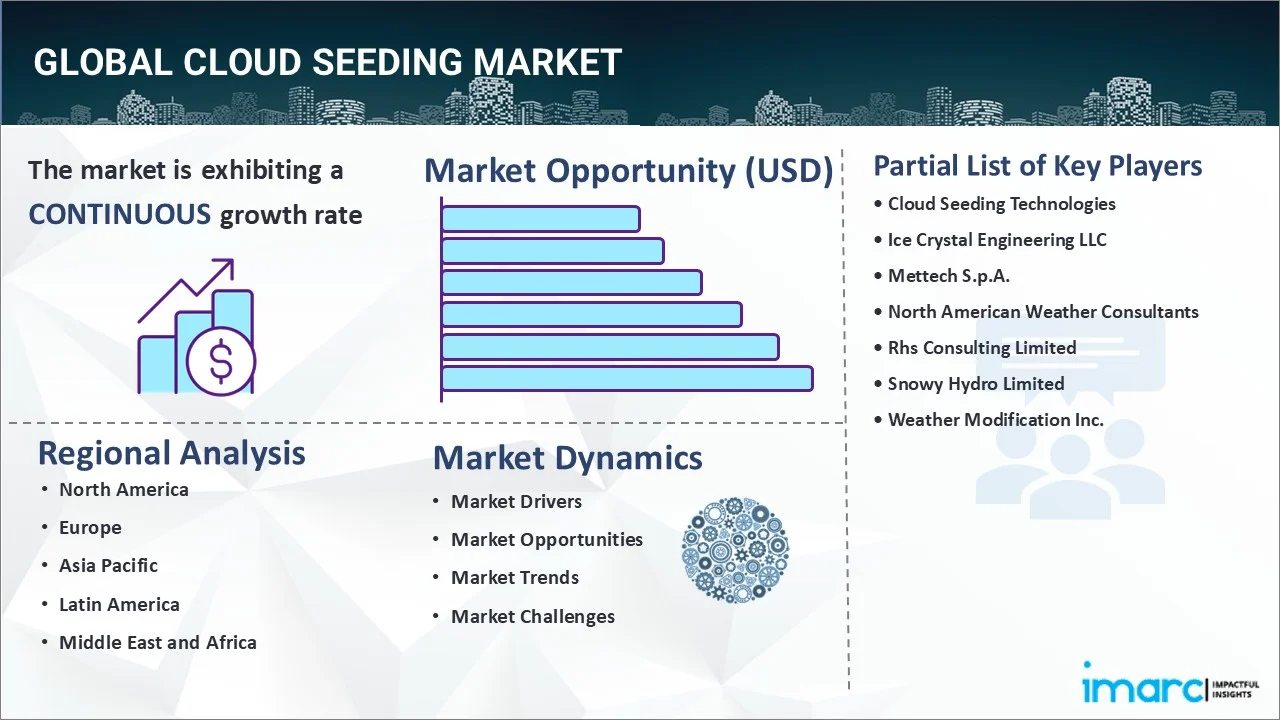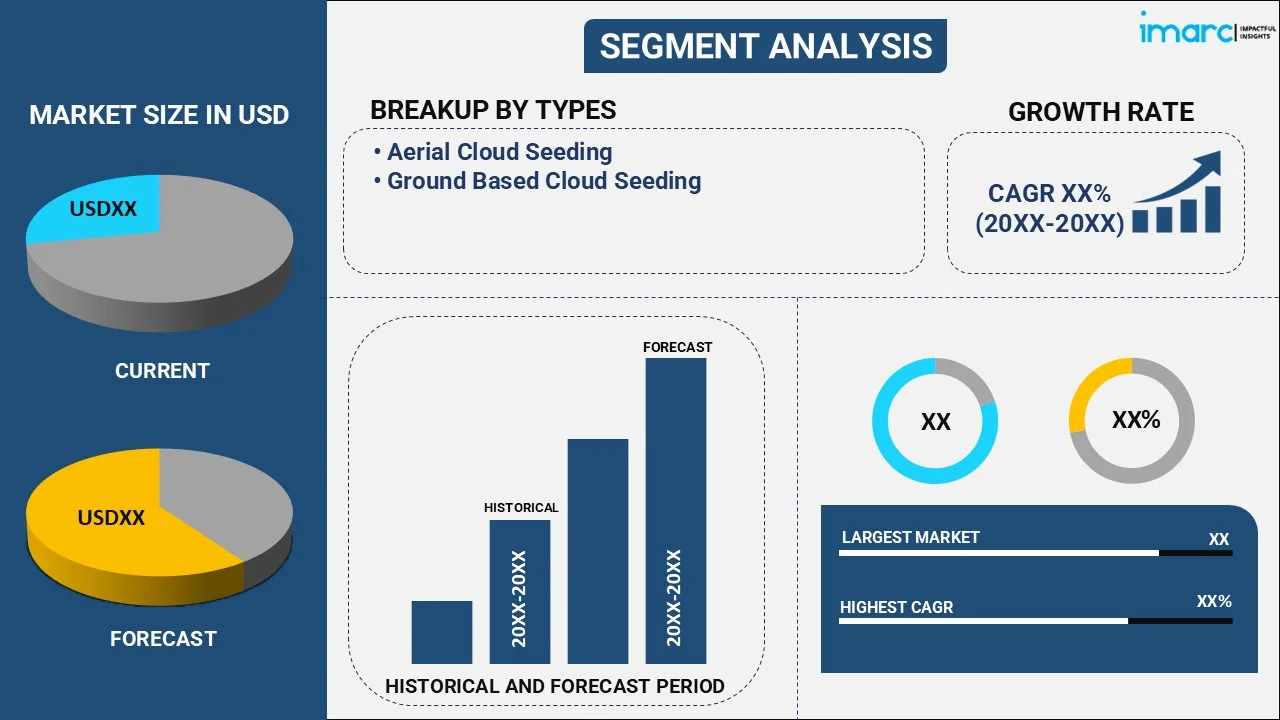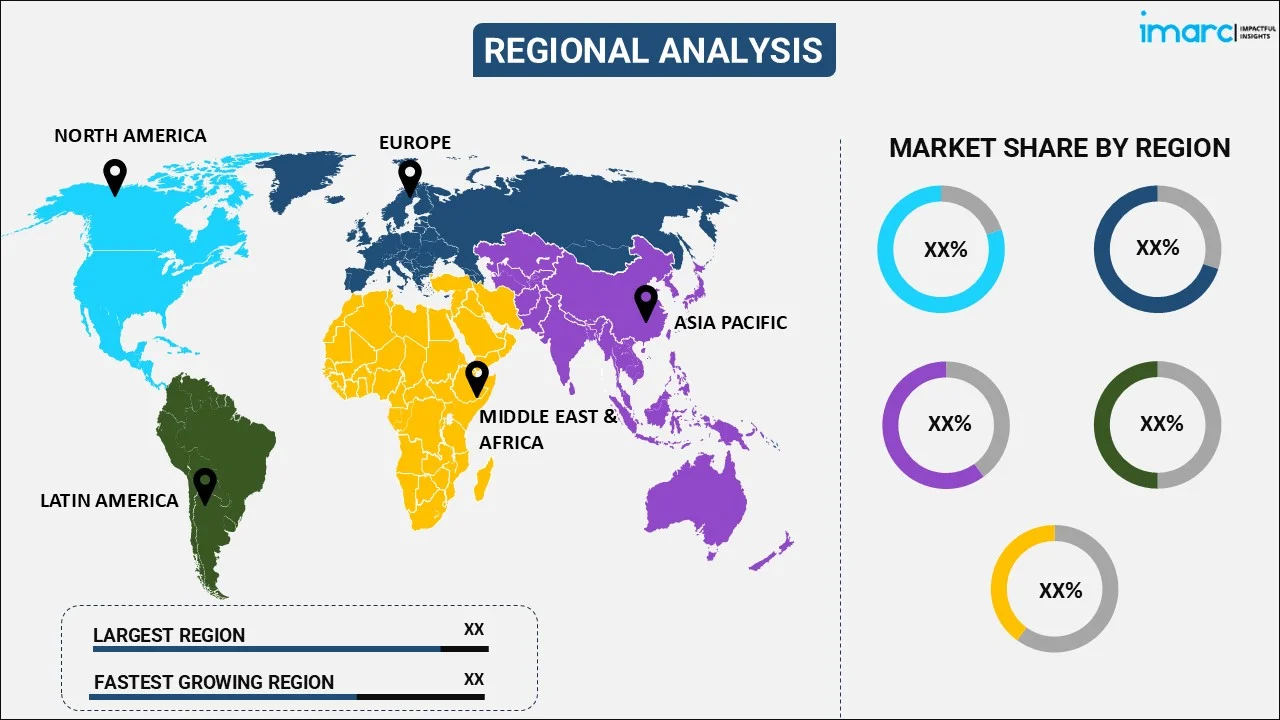
Cloud Seeding Market Report by Type (Aerial Cloud Seeding, Ground Based Cloud Seeding), Seeding Technique (Hygroscopic, Glaciogenic), Application (Increasing Precipitation, Mitigating Hail Damage, Dispersing Fog), End Use (Commercial, Government and Military), and Region 2025-2033
Cloud Seeding Market Size:
The global cloud seeding market size reached USD 143.3 Million in 2024. Looking forward, IMARC Group expects the market to reach USD 210.5 Million by 2033, exhibiting a growth rate (CAGR) of 4.5% during 2025-2033. The market is experiencing steady growth driven by rapid urbanization and infrastructural development, particularly in emerging economies, the rising focus on sustainable practices across the globe, and continuous technological advancements in manufacturing processes.
|
Report Attribute
|
Key Statistics
|
|---|---|
|
Base Year
|
2024 |
|
Forecast Years
|
2025-2033
|
|
Historical Years
|
2019-2024
|
| Market Size in 2024 | USD 143.3 Million |
| Market Forecast in 2033 | USD 210.5 Million |
| Market Growth Rate 2025-2033 | 4.5% |
Cloud Seeding Market Analysis:
- Major Market Drivers: The market is largely driven by increasing water scarcity and the rising need for agricultural sustainability. In addition to this, technological advancements and government investments enhance the market by enhancing efficiency and encouraging innovation.
- Key Market Trends: the integration of AI and machine learning into weather modification, making real-time decision-making and predictive analytics possible, is a key trend fueling the market. Another major trend is an increased focus on developing environmentally responsible cloud seeding materials and practices.
- Geographical Trends: Cloud seeding technology is gaining momentum North America due to increasing concerns over water scarcity and the need for effective weather modification strategies. The region's investment in research and development, coupled with favorable government policies, further supports the adoption of this technology. According to the cloud seeding market forecast, advancements in cloud seeding techniques are enhancing its efficiency, making it a viable solution for managing water resources in the region.
- Competitive Landscape: Some of the major market players in the cloud seeding industry include Cloud Seeding Technologies, Ice Crystal Engineering LLC, Mettech S.p.A., North American Weather Consultants, Rhs Consulting Limited, Snowy Hydro Limited, and Weather Modification Inc. Market leaders are investing in technology innovation and strategic partnerships to keep them ahead of the competition.
- Challenges and Opportunities: Environmental concerns and the implementation of stringent regulatory frameworks pose significant challenges to the widespread application of cloud seeding technology. On the other hand, increasing demand for sustainable water management solutions creates immense opportunities for market expansion and improvement in technology.

Cloud Seeding Market Trends:
Increasing water scarcity and the need for agricultural sustainability
One of the major drivers of the market is the rapidly growing water shortage around the world. Along with this, the freshwater, strained by various factors ranging from climate change and rising population to unsupportable practices in water use is increasing the need for demanding measures to improve the availability of water. Cloud seeding, or the purposeful changing of the weather to enhance precipitation, is a useful technique to mitigate water shortages. Therefore, this is propelling the cloud seeding market growth. In addition, enhanced rainfall in locations of interest supports agriculture and thus food security, providing for the sustenance of individuals in farming communities. In this way, it helps to fill up reservoirs for safe hydroelectric power generation, among other positive effects against drought. Moreover, growing demands for solutions to water security emphasize the importance of cloud seeding as a vital tool in global strategies for water management.
Technological advancements in weather modification techniques
Technological developments are positively influencing the market, especially in enhancing the efficiency and effectiveness of weather modification techniques. Improvements in cloud seeding materials, such as silver iodide and other hygroscopic agents make it possible to stimulate precipitation in much more targeted ways. Additionally, the developments in forecasting and remote sensing, along with improvements in atmospheric modeling, provide instantaneous identification of the opportunistic circumstances for cloud seeding, thereby enhancing the possible gains from cloud seeding operations. Technological achievements increase the probability of success of cloud seeding projects and unavoidably reduce the environmental risks faced. These technological advances in the discovery of the need for more efficient and reliable means to address water scarcity and manage weather-related challenges are driving cloud seeding demand. A continuously growing development of new tools and strategies is increasing the viability of cloud seeding as a sustainable solution.
Government initiatives and investments in weather modification programs
Government initiatives and investments largely drive the market. Apart from a few countries facing acute water shortages and challenges related to climate change, most countries are gradually realizing the potential of cloud seeding for improving water security and alleviating the adverse effects of extreme weather events. As such, the governments are channeling enough resources into the development and execution of cloud seeding programs. These initiatives often include cooperation with research institutions, private companies, and international for cloud seeding market recent developments and expanding areas of operations. In line with this, most governments are funding research and development and creating a legal framework that would provide safe and efficient use of cloud seeding practices. Most of these policies aim to provide transparency, ecological responsibility, and public confidence in weather modification activities. It is creating the right atmosphere, encouraging innovation, and increasing the acceptance of this technology in various sectors on account of growing governmental support across the globe. Moreover, numerous countries investing in cloud seeding programs are also supporting the market and expanding cloud seeding market recent opportunities for those stakeholders involved in the development and deployment of weather modification solutions.
Cloud Seeding Market Segmentation:
IMARC Group provides an analysis of the key trends in each segment of the market, along with forecasts at the global, regional, and country levels for 2025-2033. Our report has categorized the market based on type, seeding technique, application, and end use.
Breakup by Type:

- Aerial Cloud Seeding
- Ground Based Cloud Seeding
Aerial cloud seeding accounts for the majority of the market share
The report has provided a detailed breakup and analysis of the market based on the type. This includes aerial cloud seeding and ground-based cloud seeding. According to the report, aerial cloud seeding represented the largest segment.
Aerial cloud seeding stands as the largest segment in the market, due to its widespread effectiveness and flexibility in weather modification efforts. This technique involves deploying aircraft equipped with flares or pyrotechnic devices to release seeding agents, such as silver iodide or sodium chloride, directly into clouds. The altitude and precise placement offered by aerial methods enhance the likelihood of successful precipitation, making it a preferred choice in regions where targeted rainfall is crucial for agriculture, water supply, and drought mitigation. The ability to cover vast areas and reach cloud systems that ground-based methods cannot make aerial cloud seeding particularly advantageous which is further increasing the cloud seeding market revenue. Technological advancements in aircraft and seeding equipment have further optimized the efficiency and reliability of this method, driving its dominance in the market. Along with this, the growing investment in aerial operations, coupled with their proven success in various geographic and climatic settings, ensures that this segment leads the market.
Breakup by Seeding Technique:
- Hygroscopic
- Glaciogenic
Hygroscopic holds the largest share of the industry
A detailed breakup and analysis of the market based on the seeding technique have also been provided in the report. This includes hygroscopic and glaciogenic. According to the report, hygroscopic accounted for the largest market share.
The largest growing segment is hygroscopic, due to its effective operations in increasing precipitation over regions undergoing drought or water shortage. In this process, hygroscopic particles including salts are added to clouds and dispersed to stimulate the creation of larger droplets of water that eventually fall as rainfall. This targets certain cloud types, and its results are also independent of the changing atmospheric conditions, hence versatile and reliable. Besides, meteorological technological advancements are raising the efficiency and accuracy of hygroscopic seeding, which is creating a cloud seeding market outlook. This technique is attracting increased investment from governments and private sectors worldwide, as it offers a promising solution to the growing challenges posed by water scarcity and climate change.
Breakup by Application:
- Increasing Precipitation
- Mitigating Hail Damage
- Dispersing Fog
Increasing precipitation represents the leading market segment
The report has provided a detailed breakup and analysis of the market based on the application. This includes increasing precipitation, mitigating hail damage, and dispersing fog. According to the report, increasing precipitation represented the largest segment.
Increasing precipitation is the largest application segment in the market, driven by the critical need for enhanced water resources in drought-prone and water-scarce regions. This application involves the strategic introduction of seeding agents such as silver iodide or sodium chloride into clouds to stimulate rain or snowfall, effectively providing a boost to water availability for agriculture, drinking water supplies, and ecosystem sustainability. The cloud seeding market overview indicates that the rising frequency of extreme weather events and prolonged dry spells are driving the demand for reliable methods to enhance natural precipitation. As a result, this segment presents significant opportunities for growth and development within the cloud seeding industry. This sustained demand for precipitation enhancement solidifies its position as the leading application segment in the market, with continued growth anticipated as water scarcity challenges persist globally.
Breakup by End Use:
- Commercial
- Government and Military
A detailed breakup and analysis of the market based on the end use have also been provided in the report. This includes commercial, and government and military.
Breakup by Region:

- North America
- United States
- Canada
- Asia Pacific
- China
- Japan
- India
- South Korea
- Australia
- Indonesia
- Others
- Europe
- Germany
- France
- United Kingdom
- Italy
- Spain
- Others
- Latin America
- Brazil
- Mexico
- Others
- Middle East and Africa
North America leads the market, accounting for the largest cloud seeding market share
The report has also provided a comprehensive analysis of all the major regional markets, which include North America (the United States and Canada); Asia Pacific (China, Japan, India, South Korea, Australia, Indonesia, and others); Europe (Germany, France, the United Kingdom, Italy, Spain, and others); Latin America (Brazil, Mexico, and others); and the Middle East and Africa. According to the report, North America represents the largest regional market for cloud seeding.
The North American region leads the market due to the existing technological infrastructure in the region, huge government support, and a dire requirement for water management solutions. The United States has been at the forefront of cloud seeding initiatives and is already capitalizing on this technology in fighting water shortages and enhancing agricultural productivity to counteract droughts and wildfires. There is a large range of opportunities presented for cloud seeding, with diverse climates ranging from the arid zones of the Southwest to mountainous areas. On the Canadian front, cloud seeding is used in a manner where keeping and managing snowpack and river flows play an important role in hydropower generation and water supply. In addition to this, the strong regulatory framework of the region and heavy investment in research and development help reinforce that leadership. Government agencies are working in tandem with private companies and research institutions to come up with improvements in cloud seeding technologies iteratively.
Competitive Landscape:
- The market research report has also provided a comprehensive analysis of the competitive landscape in the market. Detailed profiles of all major companies have also been provided. Some of the major market players in the cloud seeding industry include Cloud Seeding Technologies, Ice Crystal Engineering LLC, Mettech S.p.A., North American Weather Consultants, Rhs Consulting Limited, Snowy Hydro Limited, and Weather Modification Inc.
(Please note that this is only a partial list of the key players, and the complete list is provided in the report.)
- Key players in the market are increasingly focusing on technological innovation, strategic partnerships, and expanding their service offerings to strengthen their market position. Companies such as Weather Modification International, North American Weather Consultants, and Seeding Operations & Atmospheric Research (SOAR) are investing in advanced seeding technologies, including sophisticated weather prediction models, automated seeding systems, and drones for more precise and efficient operations. Cloud seeding companies are also collaborating with government agencies, research institutions, and agricultural sectors to develop tailored solutions for specific regional and climatic needs. Furthermore, they are exploring new markets, particularly in regions facing acute water scarcity, to expand their global footprint. As climate change drives greater demand for weather modification, these companies are scaling their operations, enhancing their technical capabilities, and focusing on sustainable practices to meet the rising need for effective cloud seeding solutions.
Cloud Seeding Market News:
- July 11, 2023: Textron Aviation announced that it had been awarded a contract for one Beechcraft King Air 360CHW (cargo door, heavy weight) and four Beechcraft King Air 260 aircraft by AvMet International, LLC, located in Fargo, North Dakota, in support of the Kingdom of Saudi Arabia's National Center for Meteorology cloud seeding program. AvMet and its partners Weather Modification International, Inc. (WMI) and Fargo Jet Center, Inc. (FJC) will collaborate on the installation of Cloud Water Inertial Probes, aircraft tracking data loggers, and cloud seeding devices on four King Air 260 aircraft.
- June 22, 2023: The Indian Institute of Technology Kanpur announced that it has successfully conducted the test flight for cloud seeding. According to a statement by the premier institution, it reached an approximate height of 5,000 feet. Following the successful completion of the test ride, it landed on the IIT Kanpur lab airstrip. It said that the experiment had been conducted with due approval from the Directorate General of Civil Aviation.
Cloud Seeding Market Report Scope:
| Features | Details |
|---|---|
| Base Year of the Analysis | 2024 |
| Historical Period | 2019-2024 |
| Forecast Period | 2025-2033 |
| Units | Million USD |
| Scope of the Report | Exploration of Historical Trends and Market Outlook, Industry Catalysts and Challenges, Segment-Wise Historical and Future Market Assessment:
|
| Types Covered | Aerial Cloud Seeding, Ground Based Cloud Seeding |
| Seeding Techniques Covered | Hygroscopic, Glaciogenic |
| Applications Covered | Increasing Precipitation, Mitigating Hail Damage, Dispersing Fog |
| End Uses Covered | Commercial, Government and Military |
| Regions Covered | Asia Pacific, Europe, North America, Latin America, Middle East and Africa |
| Countries Covered | United States, Canada, Germany, France, United Kingdom, Italy, Spain, China, Japan, India, South Korea, Australia, Indonesia, Brazil, Mexico |
| Companies Covered | Cloud Seeding Technologies, Ice Crystal Engineering LLC, Mettech S.p.A., North American Weather Consultants, Rhs Consulting Limited, Snowy Hydro Limited, Weather Modification Inc., etc. |
| Customization Scope | 10% Free Customization |
| Post-Sale Analyst Support | 10-12 Weeks |
| Delivery Format | PDF and Excel through Email (We can also provide the editable version of the report in PPT/Word format on special request) |
Key Benefits for Stakeholders:
- IMARC’s industry report offers a comprehensive quantitative analysis of various market segments, historical and current market trends, market forecasts, and dynamics of the cloud seeding market from 2019-2033.
- The research report provides the latest information on the market drivers, challenges, and opportunities in the global cloud seeding market.
- The study maps the leading, as well as the fastest-growing, regional markets. It further enables stakeholders to identify the key country-level markets within each region.
- Porter's five forces analysis assists stakeholders in assessing the impact of new entrants, competitive rivalry, supplier power, buyer power, and the threat of substitution. It helps stakeholders to analyze the level of competition within the cloud seeding industry and its attractiveness.
- The competitive landscape allows stakeholders to understand their competitive environment and provides insight into the current positions of key players in the market.
Key Questions Answered in This Report
The cloud seeding market was valued at USD 143.3 Million in 2024.
The cloud seeding market is projected to exhibit a CAGR of 4.5% during 2025-2033, reaching a value of USD 210.5 Million by 2033.
Major factors propelling the cloud seeding market include rising global water scarcity and drought, agriculture’s increasing need for dependable rainfall, government backing and funding for weather modification programs, and technological advances, like drones, AI, satellites, and novel, eco-friendly seeding agents, for more precise, effective precipitation enhancement.
North America currently dominates the cloud seeding market due to drought mitigation, sustainable water management, agricultural productivity, technological innovation, and robust government funding/support.
Some of the major players in the cloud seeding market include Cloud Seeding Technologies, Ice Crystal Engineering LLC, Mettech S.p.A., North American Weather Consultants, Rhs Consulting Limited, Snowy Hydro Limited, Weather Modification Inc., etc.
Need more help?
- Speak to our experienced analysts for insights on the current market scenarios.
- Include additional segments and countries to customize the report as per your requirement.
- Gain an unparalleled competitive advantage in your domain by understanding how to utilize the report and positively impacting your operations and revenue.
- For further assistance, please connect with our analysts.
 Request Customization
Request Customization
 Speak to an Analyst
Speak to an Analyst
 Request Brochure
Request Brochure
 Inquire Before Buying
Inquire Before Buying




.webp)




.webp)












